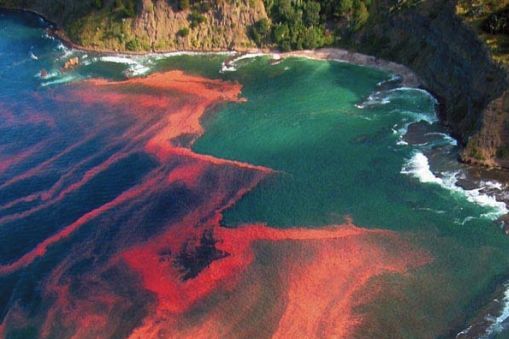Marine toxins are naturally occurring chemicals that can contaminate certain seafood. Naturally occurring toxins are produced by phytoplankton and move through the food web when zooplankton, fish and other marine life eat them. Shellfish feed on phytoplankton and zooplankton, building up prevalent toxins within them.
Red tides and harmful algal blooms (HABs)
With the right conditions – sunlight and proper nutrients – phytoplankton photosynthesise and multiply, creating a bloom. When billions of organisms are present, they may tint the water (colour varies from green to brown to red depending on the pigment in the phytoplankton). A red tide may suddenly appear in localised patches. A red tide does not necessarily mean the presence of toxins. If toxins are produced, the red tide is known as a harmful algal bloom (HAB).
Why are toxins produced?
Scientists do not know why some algae produce toxins. Most algae do not produce chemicals harmful to animals and humans. However, some types of chemicals, although not harmful to the smaller animals that ingest it, become harmful when accumulated through a food chain. Illness may occur in humans eating seafood that has accumulated certain toxins.
Types of shellfish poisoning
Many shellfish graze on phytoplankton and zooplankton. If there is a HAB, shellfish will ingest more of an algal toxin
There are four main kinds of toxic shellfish poisoning in New Zealand:
- Paralytic shellfish poisoning (PSP) – caused by saxitoxins and gonyautoxins. Symptoms are neurological and their onset is rapid. It can be life-threatening.
- Amnesic shellfish poisoning (ASP) – caused by the toxin domoic acid. Symptoms are mainly gastrointestinal, but can be neurological, causing memory loss. It can be life-threatening.
- Neurotoxic shellfish poisoning (NSP) – caused by brevetoxins. These chemicals attack the nervous system. Symptoms include diarrhoea, vomiting, tingling of the mouth and numbness and sometimes difficulty breathing. It is not fatal.
- Diarrhetic shellfish poisoning (DSP) – caused by the toxin okadaic acid. Symptoms are gastrointestinal – diarrhoea, vomiting and abdominal pain. It is not fatal.
Monitoring shellfish in New Zealand
In 1993, there was an algal bloom in New Zealand. At the time, the country had a small shellfish industry. People became sick after eating shellfish. Scientists identified algae as the problem. The shellfish in the area were tested using mouse bioassays. The mice died, so all shellfish harvesting was closed down throughout the country until the shellfish were clear of toxins (which involved more mouse bioassays). However, there were areas where there were no toxins and the shellfish were fine. The whole shellfish industry was suffering while they waited for mouse bioassays to determine that all areas of the country were free from shellfish toxins. It was agreed that mouse bioassays were not working. There had to be another more efficient way to monitor shellfish.
In 1999, the Cawthron Institute was asked to help. By the end of 2000, chemist Paul McNabb was employed, and they bought a liquid chromatography-mass spectrometry (LC-MS) machine. Paul and scientists from Cawthron established a method using LC-MS for detecting and identifying toxins. Mouse bioassays were no longer needed. Mouse bioassays could detect toxins but not identify them. The LC-MS method identified toxins by matching them with a previously identified toxin sample.
This method was refined over the next 7–8 years. It has now become an established method for detecting and identifying toxins. The European Union legislated in 2011 that, by 2012, all countries in the European Union must use LC-MS to monitor toxins in seafood. Mouse bioassay testing is now only needed for new toxins where toxicity levels need to be established.
Today, shellfish farmers take water samples and shellfish samples from their areas once a week. They send them to the Cawthron Institute. The water is tested for toxic phytoplankton and the shellfish samples for toxins. The results are copied to the Ministry for Primary Industries (MPI). MPI closes an area of shellfish farming if the toxins are above a certain level until the toxins are reduced. This might happen once or twice a year. Under the mouse bioassay system, there could be 10–20 closures over the year.
Nature of science
Scientific knowledge is developed by a process of on-going inquiry. The slowness and inefficiency of the mouse bioassay method of toxin detection badly affected the shellfish industry. This caused scientists to develop a more efficient way of detecting and identifying toxins.
The increased efficiency of the LC-MS method saves about $16 million a year. There are fewer closures and less chance of sending out toxic shellfish. With mouse bioassay testing, shellfish products often had to be recalled if shellfish were found to be toxic. With the LC-MS method, toxins can be detected at low levels and monitored so that harvesting can be stopped before the level of toxins in shellfish get too high.
Related content
Find out more about how toxicity is measured and explore how toxins enter the food web – particularly the marine food web.
Activity ideas
Investigate the ethical issues involved in using mice when researching or testing for toxins.
In Investigating toxins and bioaccumulation in marine food webs students learn about feeding connections (food webs and food chains) within a marine ecosystem. Students are also able to track marine toxins in a food web game involving the whole class.
In detecting toxins students explore the processes scientists used to analyse and identify the toxic substance responsible for the dog deaths.
Experiment with chromatography to help give your students an understanding of the liquid chromatography-mass spectrometry process that scientists use to identify known toxins.
Useful links
More information on harmful algal blooms, including a number of images related to algal blooms.
More information on shellfish toxins.
Find out more about success for the Cawthron Institute, one of only a few worldwide producers of the marine biotoxins used as reference materials when testing whether shellfish are edible.

